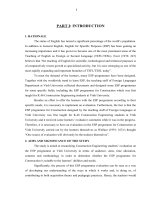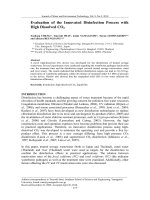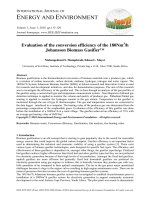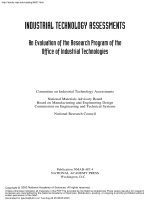Evaluation of the national food security act (NFSA) programme in Odisha
Bạn đang xem bản rút gọn của tài liệu. Xem và tải ngay bản đầy đủ của tài liệu tại đây (181.01 KB, 6 trang )
Int.J.Curr.Microbiol.App.Sci (2020) 9(7): 1965-1970
International Journal of Current Microbiology and Applied Sciences
ISSN: 2319-7706 Volume 9 Number 7 (2020)
Journal homepage:
Original Research Article
/>
Evaluation of the National Food Security Act (NFSA) Programme in Odisha
Kedarnath Mallick* and B.P. Mohapatra
Department of Extension Education, College of Agriculture, Odisha University of Agriculture
& Technology, Bhubaneswar, Odisha, India
*Corresponding author
ABSTRACT
Keywords
Evaluation,
National food
security act, PDS
Article Info
Accepted:
17 June 2020
Available Online:
10 July 2020
Public Distribution System (PDS) is a poverty alleviation programme and contributes
towards the social welfare of the people. Essential commodities like rice, wheat, sugar,
kerosene and the like are supplied to the people under the PDS at reasonable prices. The
result revealed that, almost all of the (95%) beneficiaries had opined that, they were
getting the ration in time except in some occasions. A total of 96.67% of the rural and
93.33% of the urban respondents had this opinion on the timely availability of the ration
by the FPS. It is required that as per the NFSA norms the food grain provided to the
beneficiaries should be at par with the sample put in their respective FPS. The data
revealed that though 92.67% of the beneficiaries of the rural areas revealed that the quality
was the same but 61.33% of the urban beneficiaries felt the same. Almost all the
beneficiaries of the rural (100%) as well as the urban (98.67%) sample area were getting
full quota of the food grains as per their own opinion. It was noticed that, the rural
respondents were almost satisfied about the issue and majority (92.67%) of the rural
beneficiaries had no complain about the opening of the ration shops. However, 74.67 % of
the urban beneficiaries had satisfied about the issue and only 20 % of them had
complained that, the timing of the opening was not fixed and they missed the ration due to
this reason sometimes.
Introduction
Public Distribution System (PDS) is a poverty
alleviation programme and contributes
towards the social welfare of the people.
Essential commodities like rice, wheat, sugar,
kerosene and the like are supplied to the
people under the PDS at reasonable prices.
PDS is a boon to the people living below the
poverty line. PDS is the primary social
welfare and antipoverty programme of the
Government of India. Revamped Public
Distribution System (RPDS) has been
initiated by the Government of India from the
year 1992 in order to serve and provide
essential commodities to the people living in
remote,
backward
and
hilly areas.
Government introduced Targeted Public
Distribution System (TPDS) in the year 1997.
Central Government and State Governments
have been actively involved in steering the
operations for the success of the PDS. The
1965
Int.J.Curr.Microbiol.App.Sci (2020) 9(7): 1965-1970
Government of India has enacted the National
Food Security Act (NFSA) on September 12,
2013.
The National
Food
Security
Act,
2013 (also Right to Food Act) is an Act of
the Parliament of India which aims to
provide subsidized food
grains
to
approximately two thirds of India's 1.2 billion
people. It was signed into law on 12
September 2013, retroactive to 5 July 2013.
The National Food Security Act, 2013 (NFSA
2013) converts into legal entitlements for
existing food security programmes of the
Government of India. It includes the Midday
Meal Scheme, Integrated Child Development
Services scheme and the Public Distribution
System. Further, the NFSA 2013 recognizes
maternity entitlements. The Midday Meal
Scheme
and
the
Integrated
Child
Development Services Scheme are universal
in nature whereas the PDS will reach about
two-thirds of the population (75% in rural
areas and 50% in urban areas).
Both the central and state governments are
equally responsible for the proper functioning
of the Public Distribution System. The central
government
is
responsible
for
the
procurement, storage, transportation and
allocation of the food grains and the state
governments are responsible for distributing
the food grains to the consumers through Fair
price shops (FPS) which are also known as
ration shops. The state government is also
responsible for operational responsibility
including identification of families below
poverty line (BPL), issue of ration cards,
supervision and monitoring the functioning of
the fair price shops.
Materials and Methods
For the study, survey as well as Ex-Post Facto
research was considered most appropriate to
gather data. Multiphase sampling technique
was adopted to select the districts, blocks,
panchayats, villages and respondents. As the
research study was subjective and analytical
in nature, the survey research had been
conducted through structured interview
schedule and data collection from the sample
beneficiaries of Cuttack district.
The data was obtained from 150 beneficiaries
from rural and 150 beneficiaries from urban
sample areas. Random sampling procedure
was followed for selection of blocks, villages
and sample respondents of the programme.
The data was obtained from a total of 300
beneficiaries from 10 randomly selected
villages of the sample area (5 from rural and 5
villages from urban blocks).
Results and Discussion
It is highly required that the commodities
supplied by the government order the PDS of
NFSA should reach the targeted beneficiaries
in due time, in proper sanitation, quality of
the food items and in true quantity. It is often
said and discussed that the required benefits
are not reaching the intended people properly
and there are lots of by-pass mechanism do
exist in the system. This evaluation study
aimed at analyzing those crucial areas of
timely availability, quality and quantity of the
food grains for the sample beneficiaries.
Opinion about the timely availability of
PDS materials
The success of any developmental programme
depends on the timely availability of the
intended benefits to the target audience. The
beneficiaries under the PDS should get the
food materials in due time and in proper
quantity throughout the year. It is noticed that
in many studies the authors revealed that the
beneficiaries under the NFSA are not getting
the ration in proper time and quantity. Hence
the response of the sample respondents is
obtained for analysis.
1966
Int.J.Curr.Microbiol.App.Sci (2020) 9(7): 1965-1970
The result revealed that, almost all of the
(95%) beneficiaries had opined that, they
were getting the ration in time except in some
occasions. A total of 96.67% of the rural and
93.33% of the urban respondents had this
opinion on the timely availability of the ration
by the FPS. It was indeed a highly satisfactory
note that, the beneficiaries were getting their
legitimate commodities in proper time. On
probing some of the urban beneficiaries
opined that, due to transportation problem
they were getting the ration a bit late in a few
occasions. A non significant CR value
denoted that, there was no difference of
opinion between the rural and the urban
sample beneficiaries as far as the timeliness of
obtaining of ration were concerned.
Regularity of ration throughout the year
The beneficiaries under the NFSA are getting
the ration under the PDS throughout the year
in each month. It may so happen that, some of
them are getting the irregular ration delivery
and getting two months / three months ration
at a time after the stipulated month due to
system constraints.
While in the focused group discussion with
the sample respondents in both rural as well
as the urban areas, it was noticed that, due to
strict governance in the state, and due to the
effect of vigilance machinery, most of them
were getting the ration regularly in each
month with negligible deviations.
The result revealed that, a large majority of
the (93.33%) beneficiaries had opined that,
they were getting the ration regularly
throughout the year except a very few
occasions. A total of 94% of the rural and
92.67% of the urban respondents had this
opinion on the regular availability of the
ration by the FPS. It was indeed a highly
satisfactory note that, the beneficiaries were
getting their legitimate commodities in proper
time and regularly throughout the year.
On probing some of the urban beneficiaries
opined that, due to closing of their respective
FPS for some reasons and due to the
transportation problem they were getting the
ration a bit late in a few months. A non
significant CR value denoted that, there was
no difference of opinion between the rural and
the urban sample beneficiaries as far as the
regularity of obtaining of ration were
concerned.
Quality of food grains
Quality of any food material is utmost
important for any beneficiary. It is always
checked with many parameters before final
delivery to the targeted people. But the
beneficiaries are the best evaluators of the
materials supplied to them.
It is required that as per the NFSA norms the
food grain provided to the beneficiaries
should be at par with the sample put in their
respective FPS. The data revealed that though
92.67% of the beneficiaries of the rural areas
revealed that the quality was the same but
61.33% of the urban beneficiaries felt the
same. It was a matter of some concern that
36.67% of the urban beneficiaries under
NFSA felt that the quality of the food grains
was not same as the sample given. It was
observed that though the rural beneficiaries
were mostly getting good quality of
commodities a few of urban beneficiaries
were not happy about this parameter.
However, the pooled data revealed that as
high as 77% of the beneficiaries under NFSA
were satisfied about the quality of the
commodities. A strong and highly significant
critical ration value observed with reference
to the urban and rural sample opinion. There
was much significant difference on the quality
of the food grains as per the opinion of the
beneficiaries.
1967
Int.J.Curr.Microbiol.App.Sci (2020) 9(7): 1965-1970
Quantity of food grains
Opening of ration shops
The beneficiaries under NFSA should get the
full quota of food grains as per their
eligibility. The result obtained was
satisfactory with this standard both in rural
and urban area. It is a matter of satisfaction
that, all most all the beneficiaries of the
sample area were getting full quota of ration
under NFSA.
The ration shops are the nodal delivery
centres of the food materials for the poor
people of the country. As per the norm the
FPS should open in all the working days in a
month. The beneficiaries of the rural areas
were so busy with their age old occupation
and fragile livelihood that they sometimes
miss the opportunity of lifting the ration in
time. Moreover it is the practice in some
locality of the country that the FPS is not
opening sufficiently for the delivery of the
commodities. Hence, the opinion of the
respondents is reflected in the following lines.
Many rural development programmes failed
to deliver the tangible good and services to
the beneficiaries in this country. However
regarding the quantity of the food grain it was
praiseworthy that the sample beneficiaries
could get the full quota of food grain under
the Public Distribution System. Almost all the
beneficiaries of the rural (100%) as well as
the urban (98.67%) sample area were getting
full quota of the food grains as per their own
opinion. Therefore it may be concluded that
the NFS Act was successful with respect to
supply of quantity of the food grains to the
beneficiaries. A non- significant CR value
denoted that there was no significant
difference of opinion of the rural and urban
sample respondents as far as the quantity of
food grains were concerned.
The time of opening of the Fair price Shops
and the opening hours for the beneficiaries
were crucial and critical factors for the
evaluation of the programme. The
beneficiaries often found it difficult to access
the shops as there was no fixed periodicity on
the matter. It was noticed that, the rural
respondents were almost satisfied about the
issue and majority (92.67%) of the rural
beneficiaries had no complain about the
opening of the ration shops.
Table.1 Timely availability of commodities under NFSA
Sl. Category
No.
1
2
YES
NO
Rural(n1=150)
Urban(n2=150)
Pooled(n=300)
f
145
5
f
140
10
f
285
15
%
96.67
3.33
%
93.33
6.67
%
95
5
C. R
value
0.98NS
Table.2 Regularity of ration under NFSA
Sl. Category
No.
1
2
YES
NO
Rural(n1=150)
Urban(n2=150)
Pooled(n=300)
f
141
9
f
139
11
f
280
20
%
94
6
1968
%
92.67
7.33
%
93.33
6.67
C. R
value
0.98NS
Int.J.Curr.Microbiol.App.Sci (2020) 9(7): 1965-1970
Table.3 Quality of food grains as per the FPS sample given to beneficiary
Sl. Category
No.
1
2
3
Yes
Undecided
No
Rural(n1=150)
Urban(n2=150)
Pooled(n=300)
f
139
11
0
f
92
9
49
f
231
20
49
%
92.67
7.33
0
%
61.33
6
32.67
%
77
6.67
16.33
C.
R
value
9.15**
Table.4 Quantity of food grains obtained by the beneficiaries
Sl. Category
No.
1
2
Full quota
No full quota
Rural(n1=150)
Urban(n2=150)
Pooled(n=300)
f
150
0
f
148
2
f
298
2
%
100
0
%
98.67
1.33
%
99.33
0.67
C.
R
value
0.59 NS
Table.5 Satisfaction about the opening of ration shop
Sl. Category
No.
1
2
3
Satisfied
Undecided
Not satisfied
Rural(n1=150)
Urban(n2=150)
Pooled(n=300)
f
139
3
8
f
112
8
30
f
251
11
38
%
92.67
2
5.33
However, 74.67 % of the urban beneficiaries
had satisfied about the issue and only 20 % of
them had complained that, the timing of the
opening was not fixed and they missed the
ration due to this reason sometimes. The
reason being the diversified occupation of the
dealers and they were busy in some other
occupation by closing the FPS sometimes. As
far as the pooled data was concerned it was
observed that, a small proportion of 12.66%
of the beneficiaries under NFSA were not
satisfied with the opening timing, span of
opening and regularity of opening of the
ration shop.
A significant CR value denoted that, there
was difference in the opinion of the rural and
urban beneficiaries on the satisfaction level of
the opening of ration shops. It was observed
that, few of the urban beneficiaries were more
suffering for the closing of their ration shops.
%
74.67
5.33
20
%
83.67
3.67
12.66
C.
R
value
5.31**
Therefore it was suggested that, the dealers of
urban areas should keep the ration shops open
regularly for the necessary lifting of food
grains by the beneficiaries. Moreover some of
the respondents had suggested that, the
distribution of the ration should be done by
the Self Help groups (SHG) of the locality for
ease of availability of the commodities.
In conclusion, public Distribution System
(PDS) is a poverty alleviation programme and
contributes towards the social welfare of the
people. Essential commodities like rice,
wheat, sugar, kerosene and the like are
supplied to the people under the PDS at
reasonable prices. PDS is a boon to the people
living below the poverty line. PDS is the
primary social welfare and antipoverty
programme of the Government of India.
The result revealed that, almost all of the
1969
Int.J.Curr.Microbiol.App.Sci (2020) 9(7): 1965-1970
(95%) beneficiaries had opined that, they
were getting the ration in time except in some
occasions. A total of 96.67% of the rural and
93.33% of the urban respondents had this
opinion on the timely availability of the ration
by the FPS. A total of 94% of the rural and
92.67% of the urban respondents had this
opinion on the regular availability of the
ration by the FPS. It is required that as per the
NFSA norms the food grain provided to the
beneficiaries should be at par with the sample
put in their respective FPS. The data revealed
that though 92.67% of the beneficiaries of the
rural areas revealed that the quality was the
same but 61.33% of the urban beneficiaries
felt the same. It was a matter of some concern
that 36.67% of the urban beneficiaries under
NFSA felt that the quality of the food grains
was not same as the sample given. Almost all
the beneficiaries of the rural (100%) as well
as the urban (98.67%) sample area were
getting full quota of the food grains as per
their own opinion. It was noticed that, the
rural respondents were almost satisfied about
the issue and majority (92.67%) of the rural
beneficiaries had no complain about the
opening of the ration shops. However, 74.67
% of the urban beneficiaries had satisfied
about the issue and only 20 % of them had
complained that, the timing of the opening
was not fixed and they missed the ration due
to this reason sometimes.
References
climate change for Indian agriculture,
ISPRS Archives XXXVIII-8/W3 Workshop
Proceedings: Impact of Climate Change on
Agriculture,
available
at:
www.isprs.org/proceedings/XXXVIII/8W3/FORMATTED%20ISRO%
20ABSTRACT.pdf (accessed October 15,
2014).
Amarasinghe, U.A., Shah, T. and Anand, B.K.
(2007), India’s water supply and demand
from 2025-2050: business- as- usual
scenario and issues, available at:
i.
org/pdf/H041798.pdf (accessed May 15,
2014).
Chand, R. 2003. Government Intervention in
Foodgrain Markets in the New Context.
Policy Paper 19. New Delhi: National
Centre for Agricultural Economics and
Policy Research.
Deaton, A., and Drèze, J. (2009). Food and
nutrition in India: Facts and interpretations.
Economic and Political Weekly, 44(7), 42–
65.
Dev, S. M and A. N. Sharma. (2010): Food
Security in India: Performance, Challenges
and Policies”, Oxfam India working papers
series, OIWPS- VII.
FAO (Food and Agriculture Organization of the
United Nations). 2014. FAO Rice Market
Monitor
17
(3).
Rome.
2015.
FAO Rice Market Monitor 18 (4). Rome.
www.fao.org/fileadmin/templates/est/COM
M_
MARKETS0_MONITORING/
Rice/Images/RMM/RMM_DEC15_H.pdf.
Government of India (2014): “National Food
Security Mission”, />
Aggarwal, P.K. (2008), Implications of global
How to cite this article:
Kedarnath Mallick and Mohapatra, B.P. 2020. Evaluation of the National Food Security Act
(NFSA) Programme in Odisha. Int.J.Curr.Microbiol.App.Sci. 9(07): 1965-1970.
doi: />
1970









